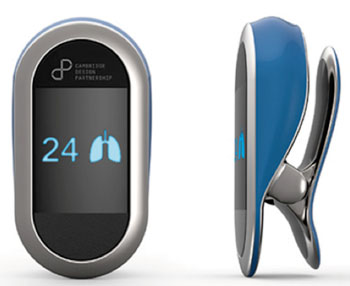Wearable Device Helps Emergency Responders Save Lives
By HospiMedica International staff writers
Posted on 10 Sep 2015
An innovative nose clip measures and monitors vital signs of multiple trauma patients in disasters and battlefield situations.Posted on 10 Sep 2015
Developed by Cambridge Design Partnership (United Kingdom), the First Response Monitor clips onto a patient’s nose and monitors both breathing and heart rate, with visual indication of both parameters. The lightweight, robust, and low-cost biometric device not only monitors the patients in real time but also collects and transmits the data wirelessly, enabling first responders to care for a greater number of casualties and provide more effective casualty treatment and improved patient outcomes.

Image: The First Response Monitor (Photo courtesy of Cambridge Design Partnership).
The data, transmitted using Bluetooth to a smartphone app or tablet, enables evaluation of multiple patient triage sorting and prioritization based on situational awareness across the entire group, as well as enabling caregivers to understand how each patient’s condition changes over time. Although the device was primarily designed for monitoring of mass casualty incidents, it has applications in many other fields, such as wellness monitoring, sports training and performance monitoring, and can also provide an inexpensive solution for low resource healthcare settings.
“With the First Response Monitor we’ve combined our expertise in wearable connected devices with our extensive medical experience to develop a technology for effectively measuring breathing and heart rate,” said James Baker, of Cambridge Design Partnership. “The monitor can help save lives in a variety of environments and we’re really keen to speak to partners about developing the potential applications further.”
Respiratory rate is often neglected by automated monitoring systems and has often been described as the “forgotten bio-sign,” since many existing wearable monitors focus on heart rate alone, and those that do measure respiratory rate have low accuracy or are difficult to use in an emergency situation. When combined with other parameters, such as heart rate and body temperature, respiratory rate can indicate life-threatening conditions.
Related Links:
Cambridge Design Partnership














